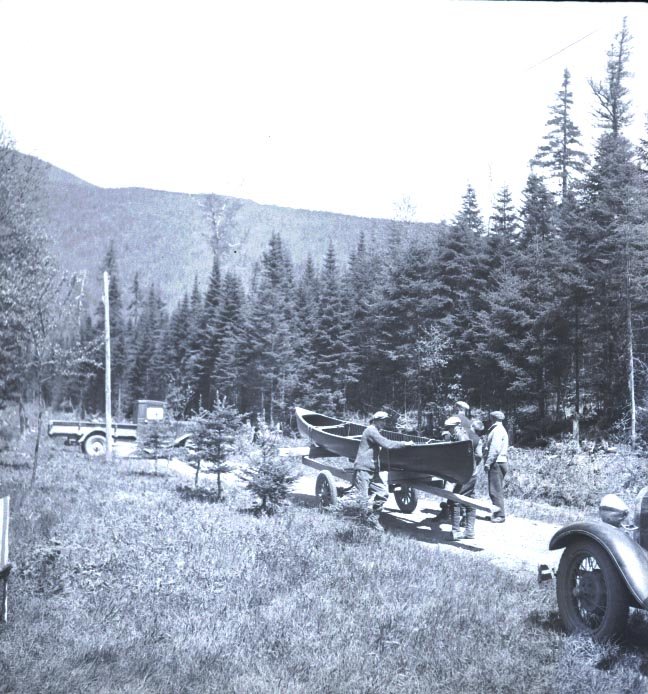Phipps Family History: The Great Cascapédia River
Like a lot of Long Islanders, the Phipps family would travel to cooler climes to beat the heat and humidity of July and August. In her memoirs, Halcyon Days, Peggie Phipps Boegner fondly recalls a vacation in Quebec, Canada:
Before and after the First World War, we would go every summer to stay with Grandpoods and Grandmoods [her maternal grandparents, Michael and Margarita Grace] in England and Scotland. Since we could not go abroad during the war, the family rented a fishing camp on the Cascapédia River in Quebec. It was a small red farmhouse right by the river. We slept outside in beds with mosquito netting tented over them like little rooms. Every day we would fish from canoes up and down the river, and when we had enough trout, we would paddle ashore to a rocky beach and put the fish in a frying pan with a rasher of bacon and grill them over an open fire.
Quebec and Maritime Provinces Map, Canada, Department of the Interior (Courtesy, David Rumsey Collection)
She also recollected about Camp Chaleur, a lodge in the style of a log cabin that her father Jay and his brothers (Hal and Howard) had built along the river.
Salmon fishing on the Great Cascapédia River, located in the Quebec portion of the Gaspé Peninsula is renowned to this day—a small allotment of fishing permits is issued annually, and anglers pay a lot of money—over $10,000 dollars a week—to cast a line into the Cascapédia because it has produced three quarters of the largest Atlantic salmon ever caught in North America.
In his book The Grand Cascapédia , the definitive history of salmon fishing on this river, Hoagy B. Carmichael (the son of the musician and songwriter, Hoagy Carmichael), provides some additional context for the Phipps’s first visit to the Cascapédia and the history of Camp Chaleur.
The person who inspired brothers Jay and Howard Phipps to visit the Cascapédia was Henry Frick, business partner of the brother’s father Henry Phipps, Sr. Frick had a membership in the club that had leases from the Canadian government to fish in several areas along the Cascapédia. As Peggie mentioned, due to the travel restrictions because of WWI, Frick decided to spend July along the Cascapédia. He also suggested to the Phipps brothers that the Grand Cascapédia would be a good place for their families to vacation in the summer of 1915. Frick arranged for the families to rent two of the more prominent lodges—one being the Red Camp, which was originally built by Robert G. Dun of Dun and Bradstreet fame. Since the families enjoyed their time so much, they decided to extend their three-week vacation to six weeks.
Image from Town and Country: August 15, 1926
The Phipps would return to the Cascapédia in subsequent years and through shrewd business dealings by Howard, the Phipps obtained leases on some of the best salmon fishing locations along the river and built a new “cottage” Camp Chaleur in 1922, which took its name from the Chaleur Bay at the mouth the Great Cascapédia. The lodge had two wings, seven bedrooms—two of which were for staff—a living room, and a common dining room. As Carmichael notes, Camp Chaleur “was unquestionably the most sumptuous camp on the river, and the first built on the Grand Cascapédia that featured indoor plumbing.”
For the next 30 years, members of the extended Phipps family would vacation along the Cascapédia. Phipps family members still hold the records for some of the largest salmon ever caught.
To learn more about the Great Cascapédia River, the allure of fishing for Atlantic salmon, and its history, visit the website of The Cascapédia River Museum. Click here for an interview with Hoagy B. Carmichael where he talks about the allure of the river and the reasons why this river remains one of the last great rivers for salmon fishing in North America.
~Paul Hunchak, Director of Public Programs and Visitor Services
Photos (l to r):
Photos 1 & 2: The Phipps children on vacation along the Great Cascapédia River, c. 1915
Photos 3 & 4: Scenes from along the Great Cascapédia River in Quebec, Canada.




